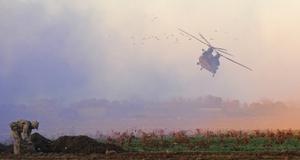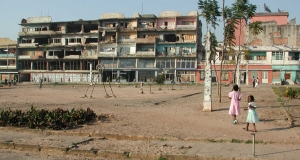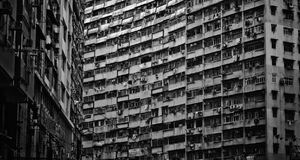Corruption and Graft in Post-Conflict AfghanistanStopping Corruption at the Source: Reorganizing the ANP/Judiciary/Courts, Refocusing Aid and Reinvigorating Afghan Civil SocietyThe pervasive nature of corruption in Afghanistan requires solutions that address a host of issues plaguing current governance structures. Thus, a three-pronged solution is required that touches on all of these issues: retooling anticorruption strategies within the police force, courts and bureaucracy; better targeting aid towards fighting corruption and building capacity with effective monitoring; and co-opting Afghans and civil society organizations in the fight against corruption. The Government of Afghanistan, through the HOAAC, should work with the corresponding departments and international actors to actualize these policy solutions. Addressing Corruption Within the JudiciaryJudicial institutions are key in monitoring corruption in other areas of governance, addressing corruption within the courts must be of the utmost priority. When it comes to corruption, Afghanistan’s primary concern is a lack of faith in judicial processes. To redress this issue, Afghanistan’s Government, the HOOAC and the MOJ must take the following steps. Empowering the Supreme Court and fostering a judicial communitySince the Supreme Court is the highest court of appeal in Afghanistan and has authority over 1500 judges in the judiciary, it needs to set a better example for lower courts in addressing issues of corruption. In the past, the Supreme Court has been used as a tool by the Karzai regime to validate the President’s actions or block the parliament’s efforts to overrule presidential vetoes (Singh, 2015, pg. 7-10). Such was the case in 2007 when Karzai used the Supreme Court to vote out then Afghan Foreign Minister Ranging Dadfar Spanta. Current President Ashraf Ghani, who has made several strong public statements promising to fight corruption, ought to reinforce the independence of the Supreme Court by depoliticizing its actions and not wielding it as a tool to assert his administration’s hegemony (Gais, 2015). He should also push court officials to go after corrupt judges.Furthermore, the Judicial Code of Conduct currently requires judges to bear a personal responsibility to report their peers but does not impose sanctions on judges who fail to do so (Singh, 2015, pg. 10). Members of the Supreme Court should work on creating a cohesive community of judges united by a code of ethics to facilitate self-monitoring and reduce instances of corruption (Greenman, 2013, pg. 701). Building legitimacy within the Supreme Court will both give Afghanistan a means of deterring corruption amongst judges and also set an example for the rest of Afghanistan’s civil servants and law enforcement officials. Furthermore, third-party groups and non-state actors will have less of an influence over a more independent Supreme Court. In the interim, the current HOOAC can be better supported (institutionally and financially) to prosecute corrupt judges, but a self-regulating community of justices combined with a robust Supreme Court will be the most effective option. Improving judicial edification, wages and securityBetter-trained, -paid and -protected judges will be less prone to corrupt acts. Only 12% of justices hold a law degree with 44% holding an Islamic law degree; additionally, current training sessions are optional and a majority of justices do not attend (Windle and Farrell, 2010, 6). Judges also often rely on informal codes, tribal laws and customs in the judicial process (7). Since these judges lack an adequate understanding of Afghan criminal codes and the Constitution, they need to be better educated and the selection process must be more regulated. While firing a majority of judges might completely incapacitate the Afghan justice system, requiring more in-depth training will not. In the future, the Afghan Ministry of Justice will have to create more stringent requirements for appointees while better regulating the process. This will also reduce the ability for non-state actors to initially insert corrupt judges into the system. Next, judges’ salaries are so meager that it forces them to take bribes. At the provincial level, Afghan judges earn close to $50 per month while Supreme Court judges are paid $80. In comparison, rent for an apartment in Kabul ranges from $150 to $200 a month on average (Tondini, 2007, 337). While raising judges’ wages alone will not fix corruption within the courts, higher salaries combined with stronger accountability mechanisms and oversight will curb the incentive for judges to take bribes. In addition to better training and paying the judiciary, judges must be better protected from external pressures, including the Taliban, warlords, militia groups and drug cartels. Between 2002 and 2010, such groups killed an estimated 30-40 judicial personnel (“Reforming Afghanistan’s Broken Judiciary,” 7, 2010). The Taliban often harass judges or even kill provincial judges for their decisions (Greenman, 2013, 702). The Afghanistan government created a special police unit tasked with protecting Afghanistan: the Department of Judicial Security Unit (JSU). However, the JSU’s dearth of financial sources and manpower has prevented the unit from succeeding in its mission (703). Physical security continues to be the strongest factor in eliciting unethical behavior amongst judges, so stronger funding and support for the JSU will be critical to ensure that justices do not succumb to external pressures. Confronting Rampant Graft Within the ANP and Afghan BureaucracyA stronger and more independent judiciary will be a principal force in monitoring corruption within both the ANP and bureaucracy. Additionally, similar practices used in curbing corruption within the courts (raising wages, improving education) can be implemented within both the ANP and the Afghan bureaucracy. A more top-down anti-corruption approach in these two sectors will be required since cultivating a community is extraordinarily difficult in departments of 100,000+ plus. Here, Robert Klitgaard’s (1988) policy framework can be applied to tackle the issue of corruption within both sectors of Afghanistan’s government. Using the principal-agent-client relationship, Klitgaard employs this equation to analyze corruption: Corruption = Monopoly + Discretion – Accountability (Klitgaard, 1988, 74-75). According to Klitgaard, “illicit behavior flourishes when agents have monopoly over clients, when agents have discretion and when accountability of agents to the principal is weak,” (75). This framework is extremely useful when applied to both the ANP and Afghan bureaucracy. Police officers and Afghan officials (agents) have immense power over Afghans (clients), requiring bribe payment in exchange for public goods like security with minimal oversight from the government and judiciary (principal) and high levels of discretion. Revamping the ANP and bureaucracy under this framework will necessitate a multifaceted approach. Selection processAs previously mentioned, ANP officers and bureaucrats are selected in an extremely partial manner and often have allegiances to third-party actors. Removing bias from the equation requires instituting an independent and thorough screening process for all officials. While agents are often selected for their expertise in a specific field, Klitgaard argues instead that “honesty” and “dependability” are even more important than technical ability when fighting corruption (Klitgaard, 1988, pg. 75). Psychologists have developed strong tests for honesty, including ones like the Reid Report and Trustworthiness attitude Scale, which evidence suggests have succeeded in predicting integrity (Cherrintong, 1981, pg. 23-24). Government agencies and companies that conduct background checks still use these tests today. The HOOAC should supervise each governmental organization in implementing a more effective, transparent and ethical process. Increasing rewards and penaltiesKlitgaard argues next that agents not only need to be paid more, but also should face stricter penalties for taking bribes. A combination of the two incentivizes agents to be more productive and stay away from illicit activities (Klitgaard, 1988, pg. 77). In terms of increasing pay, agents’ wages should be increased and be contingent upon results (pg. 77). Punishments should be contextualized with both the monetary size of the bribe and the profit made by the client as opposed to being a blanket fine or prison term (pg. 79). Gathering information and intelligenceIn order to deter corruption, the HOOAC needs to be able to detect it. Thus, the anti-corruption agency needs to create effective systems and employ information agents to gather and analyze information about other agents’ actions. The former will allow the principal to find evidence that corruption is occurring by auditing information systems to track corrupt transactions, while the latter will provide the manpower to audit, evaluate and inspect individual agents within the ANP and bureaucracy (pg. 82-83). While expensive, such monitoring institutions will be crucial in holding agents more accountable. Reduce the discretion of agentsWhile Afghanistan lacks the institutional capability to implement all of Klitgaard’s policies under this point, one action the HOOAC can take is to institute organizational and procedural changes that make agents’ opportunities for corruption much more difficult (pg. 87). The Government of Afghanistan can more clearly define policies, change rules so information agents can more easily monitor police officers and bureaucrats and require agents to work in teams to reduce discretionary ability when working with clients (pg. 88). The HOOAC prevention division has already been very successful in reducing agents’ discretion and should continue with its endeavors by implementing this strategy. Educate agents about the costs of corruptionAccording to Klitgaard,the Afghan government should invest in stronger training programs for its agents and place a stronger emphasis on the physical and moral costs of corruption. Developing an organizational code of conduct within both the ANP and the bureaucracy will reduce its officials’ affinity for illicit activities (pg. 90-91). This is a component currently missing from HOOAC’s anti-corruption initiatives, and should be adopted into its strategy as soon as possible. Targeting Aid and Improving Accountability MeasuresStructural problems that afflict Afghanistan’s judiciary, civil service and police force may institutionally promote corruption, but the method in which international actors implement foreign aid only further aggrandizes the problem. High levels of discretion in the implementation of foreign aid allows political elites to fill their coffers with aid money intended towards helping rebuild the country. Tailoring aid towards strengthening anti-corruption efforts, promoting institutional development and creating monitoring mechanisms for aid distribution will allow countries to more effectively use their aid while fighting corruption. Aiding anti-corruption effortsFrom increasing agents’ pay to creating effective monitoring institutions to collect information, the aforementioned strategies for fighting corruption will be extremely pricey. The United States and other countries that routinely donate billions to Afghanistan should reorient their spending towards these efforts. The Ghani Administration may yet make corruption its number one priority, but without the proper financial backing, any and all action will be fruitless. Additionally, all future aid should include strict anti-graft measures, as international donors decided in the Tokyo Framework of Mutual Accountability in 2012 (Perlez, 2012). The HOOAC desperately needs funding to build its capacity and enforcement mechanisms. International donors should consider bolstering its aid and human capital support for the HOOAC so it can affectively handle the number of complaints that it receives from Afghans, enforce anti-corruption laws, gather information and intelligence, and coordinate with other governmental agencies. Developing capacity institutions and delivery mechanismsIn order to build legitimacy, the central and provincial government in Afghanistan must improve its ability to deliver services and goods to the people. As international forces withdraw from Afghanistan, international aid must be better targeted towards building these institutions. For example, the Performance Based Governor’s Fund aims to “improve access to operational resources, provide provincial administrations with the means and incentives to improve planning, budgeting and auditing capacity, introduce new elements of subnational governance policy…[and] form the basis for a long-term performance-based program for Provincial Governors (Marquette, 2011, pg. 1878.” Further, the PBGF approach only allows spending in six categories: vehicles, power and equipment, transportation; maintenance and repair; communication; capacity building; and community outreach (1879). As opposed to simply providing guns and ammo, this fund is specifically targeted towards improving the basic functionality of a governing principality and even utilizes performance its aid-administering calculus. Similarly, international aid efforts should focus on these types of efforts, make aid conditional on results and target aid towards specific goals. This will improve governmental capacity while reducing discretion within the aid process itself. Build effective international monitoring institutionsInternational donors cannot rely on the Afghan government to ensure accountability. They ought to implement effective monitoring mechanisms to evaluate achievements of specific programs and use those evaluations to influence decision-making in allocating future aid. For example, efforts like the Performance Monitoring Plan and Special Inspector General for Afghanistan Reconstruction have massively increased transparency in the aid process. The United States and other foreign actors should continue using such mechanisms to maintain accountability and ensure aid money serves the right purposes. Co-Opting Civil Society and the Afghan PeopleAnti-corruption regimes and aid programs will only prove successful with the backing of Afghans and their civil society institutions. Missing from Klitgaard’s analysis is the client component; engaging the client, or the individual or group that pays the costs of corruption, is incredibly important to pressure public officials from engaging in future corrupt acts. Rasma Karklins (2005) argues that engaging the citizenry and activists in the fight against corruption is critical because citizens are the major victims of corruption; “galvaniz[ing them] to work to prevent corruption [makes it possible to] limit or even reverse the spiral of corruption,” (Karklins, 2005, 155). Afghanistan’s domestic civil-society organizations are still relatively new, but they are growing fast and can serve as an effective monitoring tool for corrupt and illicit behavior. Using homegrown organizations are likely to be more effective in uniting Afghans in anti-corruption efforts than their international counterparts because they will naturally have a more intrinsic understanding of Afghan sociopolitical institutions and practices. One specific initiative Afghanistan should consider joining is the Open Government Partnership, a multilateral organization dedicated towards strengthening the partnership between country’s civil societies and its respective government to “promote transparency, fight corruption and utilize new technologies to strengthen governance,” (Goodman and Sutton, 2015). By ratcheting up public pressure against corruption, getting Afghans on board in the anti-corruption effort can be the government’s most powerful tool in reducing corruption amongst public officials. Successfully coopting Afghans will require the HOOAC to educate Afghans about administrative policies and anti-corruption laws. Especially in rural areas, many Afghans lack phone, television and Internet access. Expanding access to these services will greatly aid and abet the HOOAC in raising awareness about government policies and current anti-corruption efforts.Continued on Next Page » Suggested Reading from Inquiries Journal
Inquiries Journal provides undergraduate and graduate students around the world a platform for the wide dissemination of academic work over a range of core disciplines. Representing the work of students from hundreds of institutions around the globe, Inquiries Journal's large database of academic articles is completely free. Learn more | Blog | Submit Latest in Political Science |


















